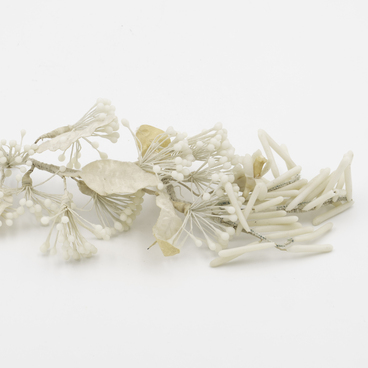Church wedding candles are considered one of the main attributes of the Orthodox marriage ceremony. During the sacrament, the newlyweds hold candles in their hands. According to tradition, the master of ceremonies, i.e., the godfather of the groom, bought the candles before the marriage ceremony. After the ceremony, the candles were carefully kept by the spouses throughout their lives. Sometimes they were attached to the icon.
There are only two types of unity candles — wax and paraffin. Wax ones are considered the most high-quality and safe because they are made of natural material. During the ceremony, such candles do not burn completely but slowly melt. They usually have a tint of yellow, which the newlyweds don’t like much. The museum collection includes paraffin candles, which are made of a synthetic substance. They are usually white or translucent in color.
Paraffin was first obtained in 1830 by the German chemist Karl von Reichenbach during the development of oil purification products. The only drawback of this material was the low melting point. Because of this, paraffin candles guttered faster than they burned. However, this drawback was eliminated by adding the stearin to them. As a result, stearin candles quickly replaced traditional wax candles.
The Orthodox marriage ceremony is a rather long process. It can last for more than an hour. The essence of it is the blessing of a new family. Following the priest, the bride and groom enter the middle of the temple with lit candles. The choir greets them with singing. The priest blesses the young family and says the prayers.
Also, two icons are needed for the ceremony: the Most Holy Mother of God and the Savior. They are usually passed down from generation to generation and are considered a symbol of a close-knit family. Icons are needed to bless the newlyweds for happy family life. During the wedding, two embroidered towels are thrown over them. A small rug (or towel), on which the bride and groom stand in front of the altar, is also considered a mandatory attribute.
At the ceremony, candles act as a symbol of love and mutual understanding, as well as a kind of talisman against family troubles in the future. They can be either simple, without decorations, or with them. For decoration, chains, glass beads, lace, ribbons, fabric are used. The only thing important is that the decor elements were paired, like two rings. It is customary to light these unity candles after the marriage ceremony on holidays — for example, on the wedding anniversary.
Many superstitions are also associated with candles. For example, a flickered out wedding candle foreshadows all sorts of troubles for the new family: a difficult life in marriage or the early death of one of the spouses.
There are only two types of unity candles — wax and paraffin. Wax ones are considered the most high-quality and safe because they are made of natural material. During the ceremony, such candles do not burn completely but slowly melt. They usually have a tint of yellow, which the newlyweds don’t like much. The museum collection includes paraffin candles, which are made of a synthetic substance. They are usually white or translucent in color.
Paraffin was first obtained in 1830 by the German chemist Karl von Reichenbach during the development of oil purification products. The only drawback of this material was the low melting point. Because of this, paraffin candles guttered faster than they burned. However, this drawback was eliminated by adding the stearin to them. As a result, stearin candles quickly replaced traditional wax candles.
The Orthodox marriage ceremony is a rather long process. It can last for more than an hour. The essence of it is the blessing of a new family. Following the priest, the bride and groom enter the middle of the temple with lit candles. The choir greets them with singing. The priest blesses the young family and says the prayers.
Also, two icons are needed for the ceremony: the Most Holy Mother of God and the Savior. They are usually passed down from generation to generation and are considered a symbol of a close-knit family. Icons are needed to bless the newlyweds for happy family life. During the wedding, two embroidered towels are thrown over them. A small rug (or towel), on which the bride and groom stand in front of the altar, is also considered a mandatory attribute.
At the ceremony, candles act as a symbol of love and mutual understanding, as well as a kind of talisman against family troubles in the future. They can be either simple, without decorations, or with them. For decoration, chains, glass beads, lace, ribbons, fabric are used. The only thing important is that the decor elements were paired, like two rings. It is customary to light these unity candles after the marriage ceremony on holidays — for example, on the wedding anniversary.
Many superstitions are also associated with candles. For example, a flickered out wedding candle foreshadows all sorts of troubles for the new family: a difficult life in marriage or the early death of one of the spouses.



